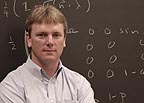July 06, 2006
Researcher wins grant for quantum computer study
CARBONDALE, Ill. "Smaller" is the watchword when it comes to manufacturing the devices that make computers work. Chipmakers make progress every day in the race to miniaturize the tiny calculators that turn "1s and 0s" into the useful information displayed on your monitor. Some such items can now be measured in atoms.
The problem is, once you reach the atomic level, all the rules change. While classical Newtonian physics govern the everyday cause-and-effect we observe in physical objects, atom-sized particles obey another set of laws. It's a field described by quantum physics.
For decades, however, leading researchers have theorized that this potential "problem" could also open a door to immensely powerful computers, if scientists can master the inherent complexities of this infinitely small world.
A researcher at Southern Illinois University Carbondale is working on those issues with an eye toward the day when so-called quantum computers change everything.
Mark Byrd, assistant professor in the physics department in the College of Science, recently received a five-year, $400,000 grant to study some of the fundamental problems preventing the development of a working quantum computer. The National Science Foundation funding will pay for graduate, doctorate and post-doctorate researchers, computing equipment and other items. It also will sponsor a national conference on quantum computing error correction likely the first of its kind — set for 2010 and hosted by Byrd at SIUC.
Much of Byrd's work is theoretical and though highly technical, he often prefers to work with plain old pencil and paper. He will work with experimentalists during portions of the grant cycle on ways to develop methods for eliminating or compensating for the errors inherent in quantum computing.
Classical computers, which rely on microprocessors and binary language, also make errors. But researchers have figured out how to account for and correct them, Byrd said.
"Many people thought the classical computer would never work because of those problems," Byrd said. He thinks the same will prove true with quantum computing.
Scientists theorized the possibility of building a quantum computer decades ago. They predicted, for example, that such a computer could factor very large integers in minutes compared to the hundreds or even thousands of years it would take a classical computer to do so. It would have broad application in the field of encryption and security, in searching large databases or in actually simulating quantum mechanical systems.
"That would be really important for scientists of all sorts chemists, biologists and physicists," Byrd said. "It could result in better drugs, for example. Or it might teach us how to extract energy from nuclear material without the harmful side effects."
But first researchers must overcome a plethora of obstacles.
Classical computers work by having a set of switches that can be in one of two positions on or off, 1 or 0. These so-called "bits" neatly mirror the way the physical world operates.
Quantum computers, which would utilize "qubits," would not be limited to those rules. Instead, a quantum computer would harness the ability of atoms to represent a 1, a 0 or virtually limitless positions in between. This characteristic, called "superposition," gives the quantum computer an inherent parallelism, which means a set of qubits can work on many calculations simultaneously, thereby making it far more powerful than a classical computer.
With computer miniaturization on the march, Byrd said researchers must find a roadmap for navigating the subatomic universe.
"When you get down to the size of two or three atoms, you have no choice but to take into account quantum effects," said Byrd, a San Antonio native who taught at the University of Toronto and Harvard University before coming to SIUC in 2003.
Scientists have made the first steps, stringing together 10 qubits that could perform calculations, Byrd said. An actual working quantum computer would involve at least several hundred such devices working in concert, he said.
"The idea is for it to be scalable to larger systems," Byrd said. "Each time we make a step we get to learn more about these systems and they behave.
"But they do make errors," he said. "All of these systems are very susceptible to errors."
That's where Byrd's work will come in. He will investigate several ways to correct the problems, including constructing codes very much like those made for classical computers that detect and correct errors. He also will look at encoding the information carried by the qubits to make it less susceptible to outside interference or "noise," and ways to manipulate the "spin" of electrons to control that phenomenon.
Scientists theorized about quantum physics nearly a century ago, but researchers have begun looking at the discipline in new ways during the last 25 years, Byrd said.
"Since about 1920, quantum physics was a good way to describe nature," he said. "But in about 1990, we began seeing it might be really useful."
Most timelines indicate researchers will make significant quantum computing breakthroughs within the next 15 years.

Searching for a quantum leap
- Mark Byrd, assistant professor
in the physics department in the
College of Science at Southern
Illinois University Carbondale,
works on a quantum physics
equation on a blackboard at
Neckers Building on the SIUC
campus. Byrd recently received
a $400,000 grant from the National
Science Foundation to study error
correction methods for futuristic
quantum computers. Download Photo
Here
